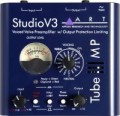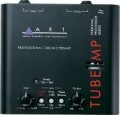Frequency range
The range of audio frequencies that the amplifier is capable of handling. The wider this range, the more complete the overall picture of the sound, the less likely it is that too high or low frequencies will be “cut off” by the output amplifier. However, note that the range of sound audible to a person is on average from 16 Hz to 20 kHz; There are some deviations from this norm, but they are small. At the same time, modern Hi-Fi and Hi-End technology can have a much wider range — most often it is a kind of "side effect" of high-end circuits. Some manufacturers may use this property for promotional purposes, but it does not carry practical value in itself.
Note that even within the audible range it does not always make sense to chase the maximum coverage. It is worth, for example, to take into account that the actually audible sound cannot be better than the speakers are capable of giving out; therefore, for a speaker system with a lower threshold of, say, 70 Hz, there is no need to look for an amplifier with this figure of 16 Hz. Also, do not forget that a wide frequency range in itself does not absolutely guarantee high sound quality — it is associated with a huge number of other factors.
Front panel
—
Display. The presence of a display on the front panel of the amplifier. Such displays may have a different design and size, but they are all used to display service information: operating mode, selected signal source, special notifications, overload messages, errors, etc. This provides additional ease of use.
— Indicators. In this case, it means that there are indicators on the front panel that indicate the currently used signal source. Usually they look like a row of light bulbs with the appropriate signatures — "Phono", "CD", "Tuner", "AUX", etc. Such pointers are not as versatile as the display, but they are still very convenient.
—
Arrow indicators. Presence on the front panel of indicators in the form of scales with arrows. Usually, such indicators are designed to display the peak level of the output signal. They make it easy to track overloads, and many users find this option more convenient and visual than displays. In addition, the arrow scales give the amplifier a stylish appearance, and, unlike the same displays, do not have complex electronics that can distort the sound. However, this category also includes other types of indicators with scales; some of them may not use an arrow, but other indicators (for example, light ones).
— Regulators behind a hidden panel. The presence of a cover on the front panel that hides the controls of the amplifier. Many models are e
...quipped with additional controls on the front panel; they can be used to adjust both the sound — volume, bass / treble, balance, etc. — and other operation parameters (for example, selecting a signal source or switching between the main and additional speakers). Sometimes these controls (as well as the front panel inputs) are provided with a cover, usually for aesthetic reasons. an abundance of small elements would give the device a sloppy appearance. The cover can also perform protective functions — for example, it reduces the amount of dust that enters the connectors.
— Input audio jack. The presence on the front panel of an input for connecting an audio signal — usually linear, in analogue format. On the one hand, such an input greatly simplifies work with signal sources that need to be connected only occasionally and for a short time — for example, MP3 players: the front panel is always in sight, while getting to the connectors on the back is sometimes very difficult. On the other hand, usually the role of the front audio jack is played by AUX IN with a 3.5 mm mini-Jack jack. This connector is not used among the main inputs, but it is quite popular in portable electronics, in particular, the players already mentioned. Some models may have a pair of RCA jacks on the front panel (see "RCA (pair)"), but this option is less common.
— Headphone output. Headphone output on the front panel of the amplifier. Headphones are portable devices, and on average you have to reconnect them significantly more often than most other components of the audio system; the output located on the front panel greatly simplifies the process.More features
— Direct connection (
By-pass/Direct). The ability to turn on the amplifier in By-pass / Direct mode. Its name is due to the fact that the signal is sent directly to the amplification stages, bypassing all additional controls (timbre, balance, etc.). Power amplifiers (see "Type"), by definition, use just such a scheme of operation. In integrated models, direct connection not only minimizes distortion in the processed signal, but also provides the sound closest to the original, which allows demanding listeners to appreciate the skill of sound engineers.
— Automatic power off. This function ensures that the amplifier automatically turns off if no signal is received from its input for a certain period of time. In this way, downtime is avoided — for example, if the owner left on business, forgetting to turn off the audio system. And considering that many modern amplifiers require a lot of energy even “at idle”, the savings can be quite significant. It is worth clarifying that in this case we are usually not talking about a complete shutdown, but about switching to standby mode; but the power consumption (see below) in this mode is usually so small that in fact the difference is practically not noticeable.
—
MM phono stage. The presence of a phono stage in the amplifier for working with turntables equipped with MM type pickups (with a moving magnet). The phono stage itself is a mandatory attr
...ibute of models with a Phono input (see "Inputs"); its necessity is due to the fact that the signal from the pickups for vinyl has specific characteristics and needs additional processing. At the same time, two types of pickups can be used in modern record players — the already mentioned MM plus MC (with a moving coil), each with its own signal characteristics. Therefore, for the normal operation of the turntable, you will anyway need a phono stage of the appropriate type. Such equipment is also available as separate devices, but it is usually easier and cheaper to buy an amplifier with a built-in phono stage.
— MS phono stage. The presence of a phono stage in the amplifier to work with turntables equipped with MC type pickups (moving coil). For more information about this function, see the subsection “MM Phono Stage” above.
— Limiter. The presence of a limiter in the amplifier — a device that limits the dynamic range of the processed signal. This device is also called an "audio signal compressor" (due to the fact that it "compresses" the dynamic range). In simpler terms, a limiter essentially reduces the difference between the quietest and loudest sound output from an amplifier. This feature can be useful in any situation where you have to deal with uneven sound volume. For example, a limiter can make it more comfortable to listen to a symphony that has large volume differences — so that the listener can access the slightest nuances of sound and at the same time, loud fragments, as they say, do not beat on the ears. And for professional concert activity, the presence of a compressor is almost mandatory — in particular, to compensate for changes in volume that occur when the distance from the microphone to the acoustic instrument or the vocalist's mouth changes. Of course, the limiter can also be made as a separate device; however, its presence in the amplifier itself is sometimes more convenient. At the same time, this function is complex and expensive, and therefore is found mainly in professional equipment and top-class consumer models.
— Connecting an additional speaker. The ability to connect an additional set of speakers (one or more) to the amplifier. Note that we are not talking about individual speakers, but about sets designed to work with full-length sound. In other words, if such an amplifier produces sound in stereo format at the main outputs (see "Number of channels"), then an additional set of acoustics will be able to work in this format. Models with this function are designed primarily for situations where you need to output sound to several rooms, and the signal can go either to all sets at once, or only to one at the user's choice. Also, an additional set of connectors can be used for Bi-Wiring (see below).
— Biwiring. Amplifiers with this feature use two separate channels of amplification for bass and treble, and are able to output each frequency band through a separate set of connectors. Due to this, it is possible to apply low-frequency and high-frequency signals via separate wires, and directly to the corresponding specialized speakers of the speaker system — instead of outputting a common signal to it and dividing it into frequencies using the built-in speaker crossover. In fact, this means that the Bi-Wiring connection reduces the likelihood of interference and improves the sound quality. However, keep in mind that this will require not only an amplifier, but also speakers that support this function. Note that Bi-Wiring is usually combined with the ability to connect an additional speaker described above.
— Management of external devices. The ability to use the amplifier as a control device for other components of the audio system — for example, preamplifier, turntable, etc. Control is usually carried out from the universal remote control supplied with the amplifier, and the control signal is transmitted through special connectors — this is much more convenient than adjusting each component separately. On the other hand, the construction of such systems is possible only from devices of the same manufacturer — different companies use different control standards, in most cases they are not compatible with each other.
— Bluetooth. A wireless communication technology with a range of about 10 m (more "long-range" versions are not used in amplifiers), originally created for direct connection between various devices. The functionality of such a connection may be different, but in this case, most often it is possible to broadcast to the sound amplifier from an external device — for example, a smartphone or laptop. However, other functions may be provided, for example, remote control from a mobile gadget through a special application.
— Emergency notification. The ability of the amplifier to work in an emergency warning system, more precisely, the availability of special functions and tools for working in such systems. Such tools may include, for example, connecting to fire detectors and automatically triggering warnings or evacuation messages to areas where the detectors have been triggered; selection of message type depending on the triggered sensor; connecting the notification microphone to the “priority input” and muting all other channels when sound is received from the microphone, etc. A specific set of features should be specified separately. Specialized security units may also be responsible for these functions, but sometimes it is more convenient to use an amplifier with built-in support for emergency notification.Power consumption
The power consumed by the amplifier during normal operation. Some manufacturers may indicate average power values, some — indicators at maximum load. However, anyway, this parameter allows you to quite adequately assess the power consumption of the device and the requirements for connected power.
In addition, it can be useful if you have doubts about the accuracy of the claimed data on the output power (see "Power per channel (8Ω)"). The basic rule is that the total power rating of all channels cannot exceed the total power consumption of the amplifier. In addition, there are special formulas that allow you to derive the maximum possible rated power depending on the power supply and type of amplifier; they can be found in special sources.

